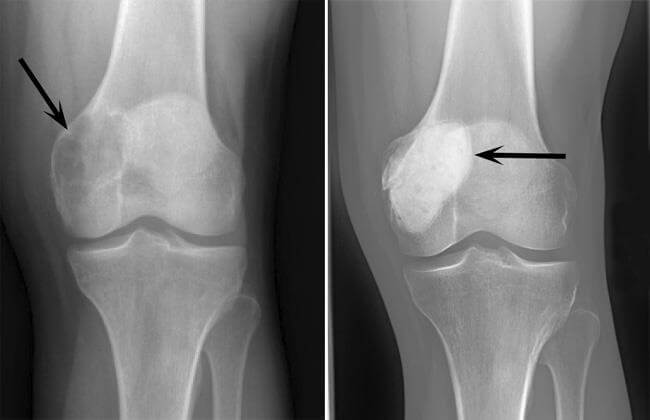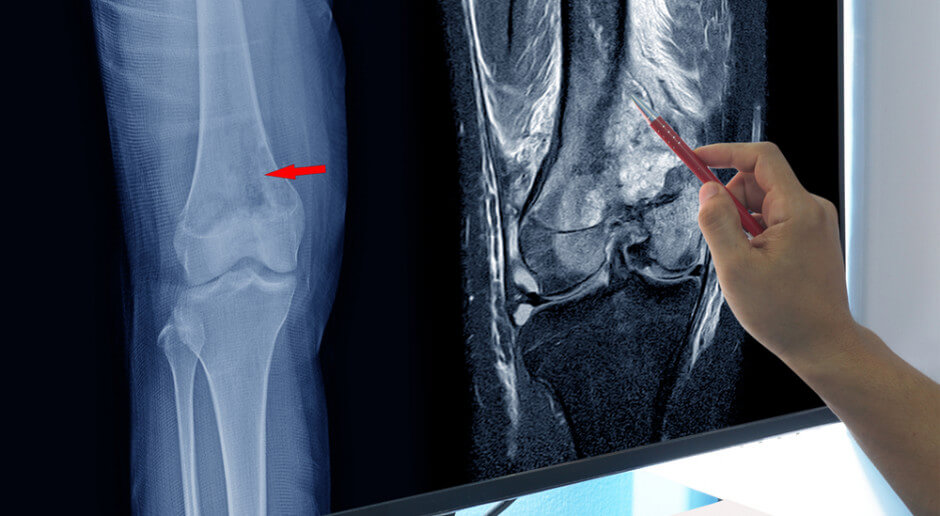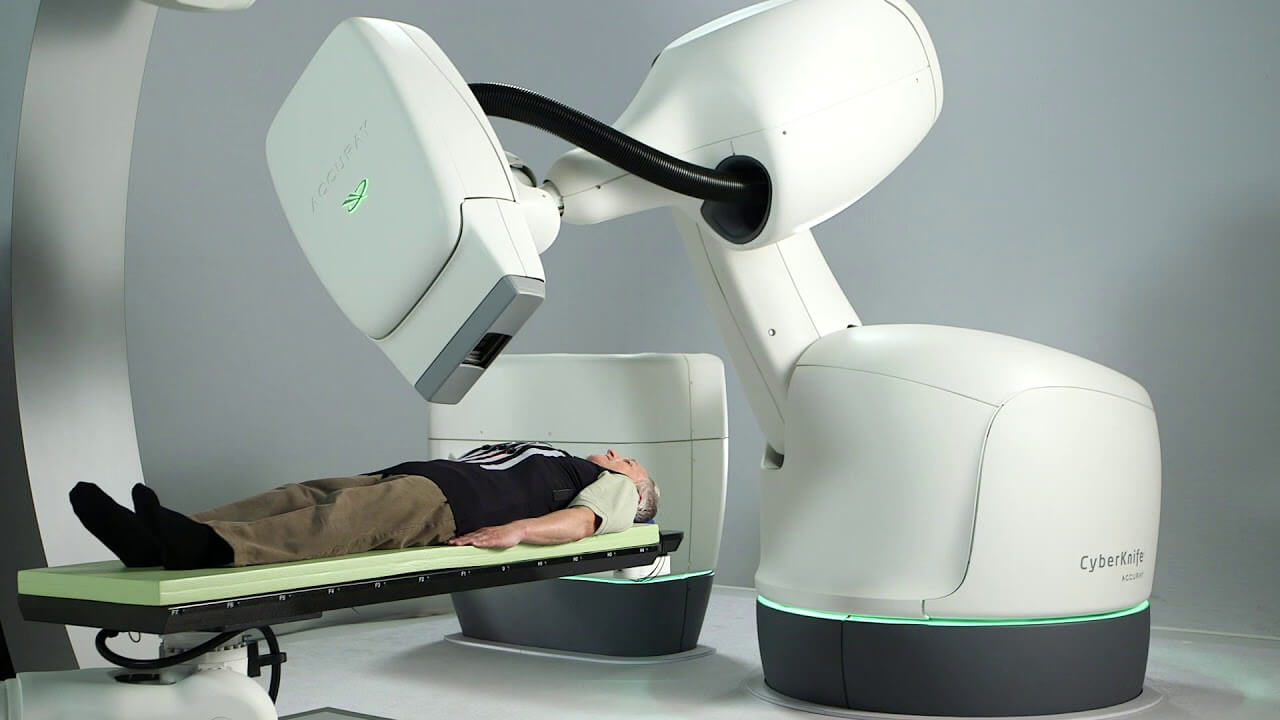Calls for Ukraine
Calls for Europe
Calls for USA

Bone cancer is not a completely correct term. In medicine, cancer is a name for malignant neoplasms that develop from epithelial tissue cells. Bones are made of connective tissue, so malignant tumors in this case are called sarcomas. In this article, we use the term “bone cancer” solely for the convenience of users.
Malignant bone tumors can be primary or secondary. Primary ones include osteosarcomas, chondrosarcomas, Ewing’s sarcomas, fibrosarcomas, chordomas, etc. These tumors most often occur in children and adolescents. Adult patients predominantly suffer from secondary cancer, which occurs when cancer cells metastasize (spread) to the bones from another area of the body.
As mentioned above, secondary bone cancer occurs through a process of metastasis. Cancer cells of the breast, lung, prostate or other organs penetrate the bone tissue and begin to reproduce similar pathological cells. That is, during a histological analysis of a bone sample, cells of the primary organ that was affected by cancer will be found in it, and not osteoblasts and osteoclasts, which normally form bone tissue.
Primary cancer develops directly in the bones. It is not yet known exactly what causes it, but certain factors increase the likelihood of developing the disease. These include some genetic disorders, such as:
Other risk factors include:
Determining the possible causes of the disease plays a certain role in choosing therapeutic tactics.

Pain from bone cancer can vary depending on a number of factors, such as the location of the tumor, its size and stage of development. The most characteristic symptom of bone cancer is local pain in the area close to the location of the tumor. It can be intense and aggravated by movement or touching the affected area. Sometimes the pain radiates (spreads) to neighboring areas of the body. Pain syndrome may also be accompanied by symptoms such as severe fatigue, weight loss and weakness.
The symptoms of malignant bone tumors are not specific, so they are difficult to detect at an early stage. Patients usually complain of dull pain in the area of the pathological focus, which gradually intensifies.
Sometimes a rapidly growing tumor is noticeable or deformation of bones and joints occurs, which limits their functioning. The soft tissue and skin around the tumor may be hot and red, falsely suggesting infectious osteoarthritis, especially if the patient has a fever. The first symptom may also be a pathological, poorly healing fracture.
You should never underestimate symptoms that may indicate bone cancer, especially if they occur in a child. Delay in diagnosis by an oncologist reduces the likelihood of successful treatment. Call or write to us, and the MedTour coordinator will select for you an experienced doctor and a clinic specializing in the treatment of bone tumors for free.

The most common types of primary malignant tumors affecting bone tissue are:
Less common types of bone cancer are:
Oncologists distinguish four stages of development of sarcomas:

The main goals of the diagnostic process are to identify the tumor, determine its type, size, stage and extent of spread. For this, the following studies are prescribed.
Sarcomas are not diagnosed through laboratory tests. Patients with osteosarcoma or Ewing’s sarcoma have higher levels of alkaline phosphatase and lactate dehydrogenase in the blood. However, this is an indirect sign that should be assessed in conjunction with the results of other studies, since the concentration of these substances may increase during fracture healing or during active skeletal growth in children.

Until 1970, surgical excision was the only treatment for osteosarcoma. Limb amputations were common to achieve clear margins, and the five-year survival rate for patients with classic high-grade tumors was less than 20%.
Surgical excision remains the mainstay of treatment for osteosarcoma. The doctor removes the tumor and a small area of surrounding tissue to prevent recurrence and metastasis. Currently, 90% to 95% of patients with osteosarcoma of the extremities avoid amputation through successful limb-sparing resections. This rate is largely due to improvements in preoperative planning using MRI, advances in soft tissue and vascular surgery, and the use of new treatments such as vaccine therapy.
Limb amputations are still necessary for some large tumors, in cases where vital vascular structures are affected by the disease, and in cases of poor response to chemotherapy.
Chemotherapy before and after surgical excision is the standard of care for locally advanced and metastatic Ewing sarcomas. The main difference between the treatment of Ewing’s sarcoma and osteosarcoma is the use of radiation therapy as an alternative to surgery. Radiation therapy is used for primary lesions that are not amenable to surgical resection due to the location or size of the tumor.
When possible, doctors generally prefer surgery because free-margin excision improves survival for Ewing’s sarcoma. Radiation is also thought to cause more serious long-term effects by slowing bone growth in children.
Unlike osteosarcoma and Ewing’s sarcoma, chondrosarcoma is usually resistant to chemotherapy. It is believed that malignant cartilage cells have limited vascular connections, making the delivery of chemotherapy drugs ineffective. Surgical resection is the mainstay of treatment for primary and metastatic chondrosarcoma. Similar to the treatment of Ewing’s sarcoma, radiation therapy is used in cases where adequate surgical margins cannot be achieved.

CyberKnife is a non-invasive alternative to surgery for the treatment of primary and secondary malignant bone tumors that are considered inoperable due to location.
CyberKnife’s sophisticated software helps determine the exact location of the tumor in real time using X-ray images. This makes it possible to precisely deliver radiation to the tumor, minimizing damage to surrounding healthy tissue.
The main advantages of CyberKnife technology:
CyberKnife radiation therapy requires 1-5 visits, so it can be used as part of a multimodal treatment without interruption of a chemotherapy or immunotherapy cycle.
Targeted drugs used to treat certain types of bone cancer are known as kinase inhibitors. Kinases are proteins in a cell (or on its surface) that transmit signals to cause the cell to grow or divide. Blocking certain kinases may help stop or slow the growth of some tumors.
It is important to note that no single drug can be universally effective for all types of osteosarcoma, which emphasizes the importance of identifying the genetic “portrait” of the tumor for subsequent personalized treatment.
Call or write to us. The MedTour coordinator will tell you what tests you need to take, and will also select a clinic for diagnosing and treating osteosarcoma.

The occurrence of osteosarcoma may be associated with dysfunction of dendritic cells. Research has shown that patients suffering from this cancer have high levels of dendritic cells that are dormant or inactive. Therefore, the effectiveness of vaccine therapy is very high, while chemotherapy does not always lead to success, even if the therapeutic protocol includes several aggressive chemotherapy drugs.
In case of chemoresistance, the use of cancer vaccines is the only chance to reduce the size of the tumor and slow down the process of metastasis. After vaccination, the need for amputation and the risk of disability are reduced. Immunotherapy has a complex effect on the patient’s body, activating his own immune system to fight the disease.
To learn more about the possibility of treating bone cancer using immunotherapy, contact the MedTour coordinator in any way convenient for you. The medical coordinator will provide you with detailed information, help you choose a clinic and organize treatment.
Survival rates for bone sarcoma vary depending on several factors. These include the stage of the cancer, the person’s age and general health, and how well they respond to treatment. Other factors that may influence outcome include the type of bone sarcoma.
Five-year relative survival rates for various types of bone cancer
| Tumor type |
Overall survival |
Localized tumor | Locally advanced tumor |
Metastatic tumor |
| Chordoma |
79% |
86% | 85% |
61% |
| Chondrosarcoma |
79% |
91% | 75% |
21% |
| Ewing’s sarcoma |
62% |
82% | 70% |
39% |
| Osteosarcoma |
60% |
77% | 65% |
26% |
The most common sign that cancer has metastasized to the bone is sudden, recurring pain. It can arise and pass, gradually becoming permanent. As cancer progresses, bones become brittle and the risk of spontaneous fractures increases. Another indirect sign is hypercalcemia (increased calcium levels in the blood), which is associated with the process of destruction of bone tissue.
Bone cancer is a complex disease, so its treatment is best carried out in a specialized clinic. MedTour company cooperates with the best clinics in the world specializing in the treatment of bone sarcomas. Call or use the feedback form to get a free consultation with MedTour coordinating doctors. Our specialist will tell you in detail about new methods of treating bone cancer, help you choose a suitable clinic and organize the therapeutic process.
The success of bone cancer treatment largely depends on the level of qualifications and experience of the doctor. MedTour cooperates with the best oncologists specializing in the diagnosis and treatment of bone sarcomas. Write or call us, and the medical coordinator will help you find a good doctor who has access to the latest antitumor techniques and will draw up an individual therapeutic plan that takes into account the characteristics of your disease and general health.
Please rate the work of MedTour
